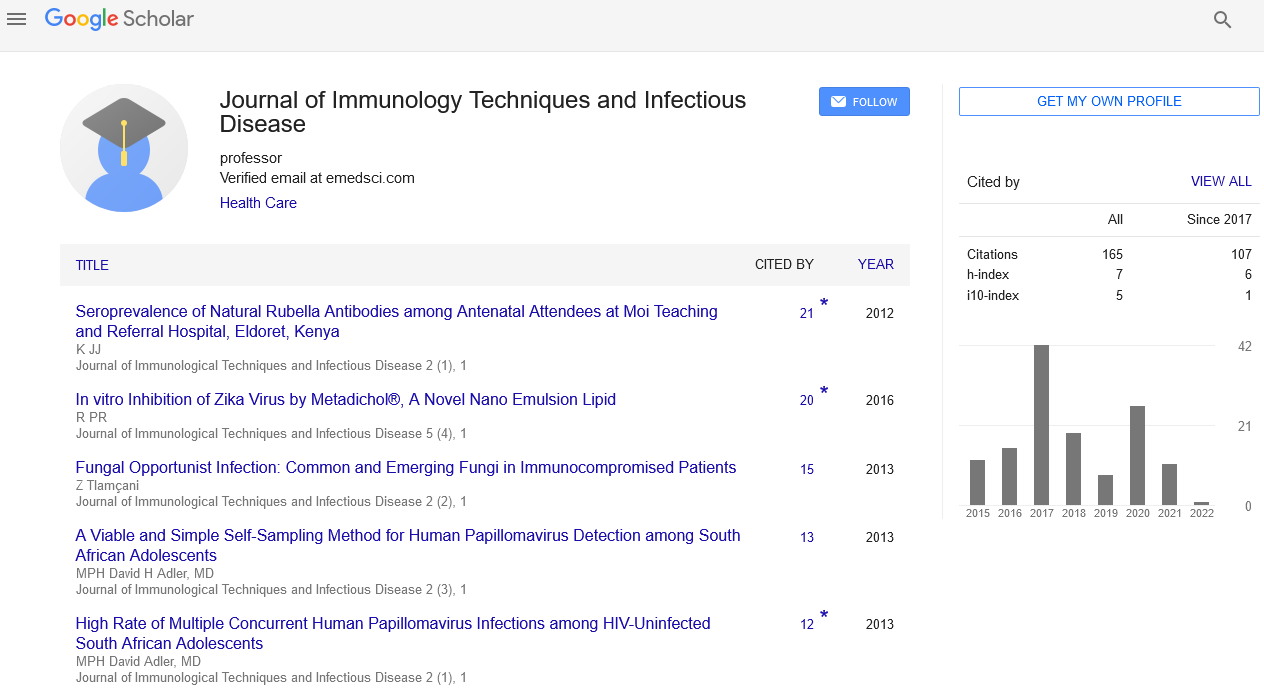Opinion Article, J Immunol Tech Infect Dis Vol: 12 Issue: 1
Vancomycin-Resistant Enterococci: Diagnosis and Treatment
Patric Joris*
Department of Biochemistry and Molecular Biology, Drexel University College of Medicine, Pennsylvania, USA
*Corresponding Author: Patric Joris
Department of Biochemistry and Molecular
Biology, Drexel University College of Medicine, Pennsylvania, USA
E-mail: patric.joris@gmail.com
Received date: 01-Feb-2023, Manuscript No. JIDIT-23-92849;
Editor assigned date: 03-Feb-2023, PreQC No. JIDIT-23-92849 (PQ);
Reviewed date: 17-Feb-2023, QC No. JIDIT-23-92849;
Revised date: 24-Feb-2023, Manuscript No. JIDIT-23-92849(R);
Published date: 03-Mar-2023, DOI: 10.4172/2329-9541.1000334.
Citation: Joris P (2023) Vancomycin-Resistant Enterococci: Diagnosis and Treatment. J Immunol Tech Infect Dis 12:1.
Description
The infections caused by gram positive bacteria strains of entrococcus species - Vancomycin Resistant Enterococci (VRE) have been severely, constrained over the past two decades as these pathogens have grown to be significant nosocomial pathogens. Methicillin-resistant Staphylococcus aureus, possibly the most well-known nosocomial pathogen, was previously resistant to vancomycin and other glycopeptides. The emergence of vancomycin-resistant strains of S. aureus has developed options for treating serious infections caused by these organisms are very restricted. Vancomycin resistance is also increasing in clinically relevant isolates of coagulase-negative staphylococci in numerous settings. The purpose of this to the genetic basis of vancomycin resistance in Enterococcus species and Staphylococcus aureus it also focuses on critical factors to consider when detecting vancomycin resistance in these gram-positive bacteria the issue of glycopeptide resistance in clinical isolates of coagulasenegative staphylococci, as well as vancomycin tolerance shown in some Streptococcus pneumoniae strains.
Vancomycin works by suppressing the formation of peptidoglycan precursors of the bacterial cell wall by blocking the transglycosylation step and thereby impacting the transpeptidation stage as well. Transglycosylation and transpeptidation are both required for bacterial cell wall cross-linking. Vancomycin-Resistant Enterococci (VRE) with resistance to glycopeptides such as vancomycin and teicoplanin have already been documented from all over the world, and they exhibit phenotypic and genotypic variation. There are six known vancomycin resistance phenotypes: VanA, VanB, VanC, VanD, VanE, and VanG. Gene clusters associated with these traits have been identified. Vancomycin resistance gene clusters (vanL, vanM, and vanN) have recently been found.
The main causes of VRE infections are the overuse and misuse of antibiotics, which can lead to the development of antibiotic-resistant bacteria. Patients with weakened immune systems, such as those undergoing chemotherapy or organ transplants, are at a higher risk of developing VRE infections. The symptoms of VRE infections are similar to those of other bacterial infections, including fever, chills, and nausea. The rising prevalence of MRSA infections has resulted in the widespread usage of vancomycin to treat these infections. In fact, vancomycin is the preferred treatment for MRSA infections. However, abuse of this antibiotic has resulted in the creation of S. aureus strains that are less susceptible to vancomycin. A clinical strain of methicillin-resistant S. aureus with reduced vancomycin susceptibility. Mu50 was isolated from pus from a 4-month-old male child with pulmonary atresia's sternal incision site.
Vancomycin has been the medication of choice for severe betalactam- resistant gram-positive infections. Resistance to this glycopeptide, as well as other glycopeptide agents such as teicoplanin, has emerged and spread among clinically important gram-positive cocci such as Enterococcus species, S. aureus, and coagulase-negative staphylococci, making it difficult to manage serious infections caused by such pathogens. Vancomycin resistance has not yet arisen in certain important pathogens, such as Streptococcus pyogenes, Streptococcus agalactiae, and Streptococcus pneumoniae. Treatment for VRE infections can be challenging, as the bacteria are resistant to many antibiotics. In some cases, a combination of antibiotics may be used to treat the infection. However, prevention is key in controlling the spread of VRE infections. The presence of vancomycin-tolerant strains of S. pneumoniae, on the other hand, is cause for alarm. In the treatment of serious gram-positive infections, it is critical to explore for alternatives to vancomycin and other glycopeptides. It is also critical to take effective infection control measures to prevent the development and emergence of glycopeptide resistance.
 Spanish
Spanish  Chinese
Chinese  Russian
Russian  German
German  French
French  Japanese
Japanese  Portuguese
Portuguese  Hindi
Hindi 
